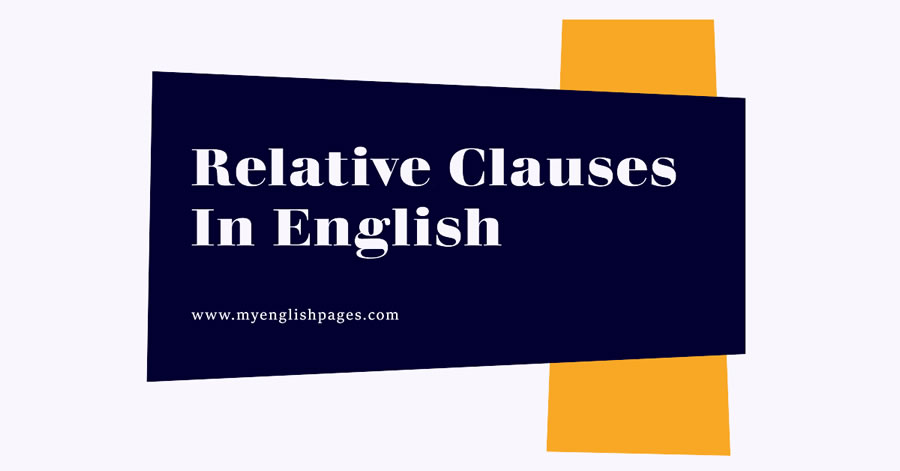Table of Contents
Introduction
This article will explore relative clauses in English grammar. We will also discuss how relative pronouns are used to form relative clauses. Understanding these concepts will enhance your writing and communication skills.
What is a Relative Clause?
A relative clause, a type of subordinate clause, serves to modify a noun or noun phrase. It provides essential information that defines or identifies the person or thing under discussion.
- Example: “The man who is smoking is the murderer.”
Here, the relative clause “who is smoking” modifies the noun “the man.” This clause is introduced with the relative pronoun “who”.
What are the relative pronouns in English?
List of Relative Pronouns
Relative pronouns are used to introduce relative clauses. Here’s a list with examples:
| Pronoun | Use | Example |
|---|---|---|
| who | Subject or Object Pronoun for People | They caught the lady who killed her baby. |
| which | Subject or Object Pronoun | I read the book which is on the table. |
| that | Subject or Object Pronoun for People, Animals, and Things | I like the vase that is over there. |
| whom | Object Pronoun for People | The boy whom you told me about got the best grades in mathematics. |
| whose | Indicates Possession | The man whose car was stolen reported the incident. |
Relative Pronoun as Subject or Object
Understanding whether a relative pronoun functions as a subject or object is crucial:
- Subject Pronoun: If a noun or pronoun does not follow the relative pronoun, it is likely a subject pronoun.
- Example: “The apple which is lying on the table is sweet.”
- Explanation: In this sentence, “which” refers to “the apple,” acting as a subject. Breaking it down, we observe that “The apple” functions as a subject:
- The apple is sweet. The apple is lying on the table.
- Object Pronoun: If a noun or pronoun follows the relative pronoun, it is likely an object pronoun.
- Example: “The movie which we watched yesterday was fantastic.“
- Explanation: In this sentence, “which” refers to “the movie,” serving as an object. Breaking it down, we recognize that “The movie” acts as an object:
- The movie was fantastic. We watched the movie yesterday.
The same can be said about these relative clauses:
- She met the agent who works for the police department. (Subject)
- They are promoting the product that they have just launched. (Object)
- The person who sent the invitation is my cousin. (Subject)
- I have a friend whom I trust completely. (Object)
Relative Adverbs
In addition to pronouns, relative adverbs such as where, when, and why may be used in relative clauses:
- where: Referring to a place.
- Example: “The restaurant where I usually have dinner is nice.”
- when: Referring to a time.
- Example: “There are times when I feel so lonely.”
- why: Referring to a reason.
- Example: “This is why she refused the offer.”
Types of Relative Clauses
There are two types of relative clauses: Restrictive and Non-restrictive.
Restrictive Relative Clauses
Restrictive relative clauses, also known as defining or essential relative clauses, provide essential information that is necessary to clearly identify or define the noun they modify.
These clauses are not set off by commas and are integral to the meaning of the sentence.
Examples:
- I know the man who is standing there.
- The car that is parked in the driveway belongs to my neighbor.
- The student who scored the highest will receive a scholarship.
- I appreciate the book that you recommended.
- The house that was built in the 19th century is now a museum.
- The project that we discussed yesterday needs immediate attention.
Non-Restrictive Relative Clauses
Non-restrictive relative clauses, also known as non-defining or non-essential relative clauses, provide additional information that is interesting but not crucial to the identification or definition of the noun they modify.
These clauses are set off by commas and can be removed without altering the core meaning of the sentence.
Examples:
- Martin Luther King, who was known for his fight for civil rights, was assassinated in 1968.
- My sister, who is a doctor, is coming to visit.
- The Eiffel Tower, which was completed in 1889, is an iconic landmark.
- Our cat, whose favorite spot is the windowsill, loves to watch birds.
- The movie, which won several awards at the film festival, is now available online.
- My grandparents, who celebrated their 50th anniversary last month, are throwing a party.
More about restrictive and non-restrictive clauses here.
Subject-Verb Agreement in Relative Clauses
Keep in mind that a relative pronoun takes the place of a noun, whether it’s singular or plural. The verb in the relative clause should match the original noun.
Maintaining agreement between subjects and verbs in relative clauses is crucial for clarity:
Example:
- The team that is performing well deserves recognition.
- The boy who is playing in the park is happy. (singular)
- The kids who are playing in the park are happy. (plural)
- The cat that is sleeping on the couch looks comfortable. (singular)
- The dogs that are barking in the yard seem excited. (plural)
Reducing Relative Clauses
Certain types of relative clauses can be “shortened” or “reduced.” Subject pronouns can be omitted by adding “-ing” or “-ed” to the verb.
Example 1:
- Original: I made the food that is lying on the table.
- Reduced: I made the food lying on the table.
Example 2:
- Original: She read the book that was recommended by the librarian.
- Reduced: She read the book recommended by the librarian.
Object pronouns can also be omitted.
Example 1:
- Original: I hate the man whom I met.
- Reduced: I hate the man I met.
Example 2:
- Original: The book that I read yesterday was fascinating.
- Reduced: The book I read yesterday was fascinating.
Conclusion
Relative clauses are essential elements in constructing complex sentences. They are introduced with relative pronouns such as “who,” “which,” “that,” and others.
There are two types of relative clauses: restrictive and non-restrictive. Restrictive clauses provide necessary information without the use of commas, while non-restrictive clauses offer additional, non-essential details and are set off by commas.
Ready to test your knowledge? Check out our exercises on relative clauses and reinforce your understanding:


